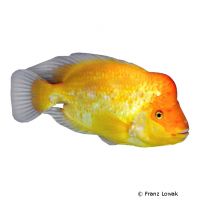Midas Cichlid (Amphilophus citrinellus)
| Midas Cichlid Amphilophus citrinellus | |
|---|---|
| Name | Midas Cichlid |
| Name Lat. | Amphilophus citrinellus |
| Synonym | Cichlasoma citrinellum |
| Family | Cichlids |
| Family lat. | Cichlidae |
| Order | Cichlids |
| Order lat. | Cichliformes |
| Origin | Central America |
| Habitat | Lakes, tributaries |
| Diet | Omnivore |
| pH | 6.0-8.0 |
| Behavior | Aggressive |
| Keeping | Pair |
| Care Level | Difficult |
| Reproduction | Substrate spawner |
| Breeding | Simple |
| Life Span | 8-12 years |
| Protection | No |
| Metric Units | |
| Size | 25-30 cm |
| Temperature | 22-25 °C |
| Hardness | 10-20 °dH |
| Aquarium | 370 l |
| US Units | |
| Size | 10"-12" |
| Temperature | 72-77 °F |
| Hardness | 178-356 ppm |
| Aquarium | 100 gal |
Distribution and habitat
The lemon cichlids are common in Nicaragua and Costa Rica, where they live in large and small lakes (Lake Nicaragua, Lake Managua, Lake Masaya, etc.) and in slow-flowing tributaries of the Rio San Juan. They prefer rocky shores and bottoms with boulders, where they search for food in the crevices.
Maintenance
They need a richly structured aquarium with stones, rock structures and roots (hiding places) and that offers plenty of swimming space. A deep, sandy substrate for burrowing and subdued light (floating plants) is ideal.
No ammonia, ammonium and nitrite should be detectable, the nitrate value should not exceed 100 mg/l. To ensure water quality and oxygen content, a filter and heater adapted to the aquarium size is required, as well as lighting for the species-appropriate day-night rhythm of the animals.
Diet
The food supply consists of high-quality dry food for cichlids (pellets, granules), supplemented with live or frozen food, such as mysis, red mosquito larvae, shrimp with shell and mussel meat or a commercial frozen special food mix for large cichlids, as well as earthworms or meal beetle larvae for adult animals. In addition, they need regular vegetable food, such as spinach, crushed peas, algae leaves or dry food with high vegetable content (spirulina).
Only feed as much as is eaten immediately (in a maximum of 10 minutes). Regular and varied feeding promotes health and increases resistance.
Behaviour and compatibility
It is recommended to keep them in pairs. They are very aggressive and behave very territorial not only at spawning time. Keeping several pairs is only possible in a much larger and richly structured tank. They should only be socialized with larger and robust fish. Fish that are too small are considered prey. Basically, only compatible fish species with similar demands on water quality and water temperature should be socialized.
Sex dimorphism
Males are stronger, have longer, more pointed dorsal and anal fins, and a larger frontal hump. With some experience, the sexes can be distinguished by their genital papilla, which is thinner and longer in the male.
Reproduction and breeding
They spawn in a cave or a sloping, often vertical hard substrate (e.g. stone). Both parents engage in intensive brood care (parental family) and vigorously defend the territory. After 2-3 days the fry hatch, which are then housed and guarded in a bottom pit prepared outside the cave until they swim freely after 5-7 days. At the latest then the female should be separated for protection from the hyperaggressive male.
Juveniles must be fed several times a day with special rearing food (e.g. Artemia nauplii).
Important
In nature, there are different colored site variants, but they are also bred in some color variants, such as white, yellow, gray, orange and red
They rummage through the substrate in search of food. Accordingly, stone structures must be very stable. Plants should be placed in heavy pots and secured with stones against burrowing, but planting is not necessary.
The well-being of the fish should be checked regularly. Temperature should be checked daily, pH, hardness, and nitrate levels at least every 14 days. Regular partial water changes are recommended, even if the pollutant load has not yet reached the upper limit. Sudden changes in water quality should be avoided. Newly introduced fish must be accustomed slowly to the water in the aquarium.
Further literature can be found in your pet store.
References
Text: Werner Winter; Image: Franz Lowak
Source: BMELV (1998): Tierschutzgutachten - Haltung von Zierfischen (Süßwasser); BAENSCH & RIEHL (2004): Aquarien Atlas Bd. 2, Mergus Verlag; ENGELMANN (2005): Zootierhaltung - Tiere in menschlicher Obhut: Fische, Verlag Harri Deutsch
- Gemäß § 21 Abs. 5 Tierschutzgesetz idgF
